Monthly Archives: July 2019
 In a world where we have all become professionals at photography, carrying our cameras with us all the time, because they are built into our phone, the selfie picture has become the norm in society. We use every version of facial expression from a smile, to a pout, to a look of shock, to a look of anger…real or faked. We use no smile, a toothy grin, or a soft closed-mouth smile, or we might even pucker up, or stick out our tongue. The idea of the unusual or even ridiculous smile is as commonplace as is picture taking itself.
In a world where we have all become professionals at photography, carrying our cameras with us all the time, because they are built into our phone, the selfie picture has become the norm in society. We use every version of facial expression from a smile, to a pout, to a look of shock, to a look of anger…real or faked. We use no smile, a toothy grin, or a soft closed-mouth smile, or we might even pucker up, or stick out our tongue. The idea of the unusual or even ridiculous smile is as commonplace as is picture taking itself.
It wasn’t always so, however. When we look at pictures from the early days of photography, the people almost always appear straight-faced, and almost angry. Many people theorized that they didn’t smile because they had bad teeth. It was all too common prior to the days of modern dentistry. As it turns that wasn’t the case, since there were plenty of individuals who had fabulous teeth, yet still kept their mouths shut during pictures. Not to mention, humans can smile without showing their teeth. Another theory was that that because the cameras of old took time to set up and had a long exposure period, anywhere from five minutes to more than 30. It was impractical to hold a smile so long. While that idea does make sense, it doesn’t explain why subjects were 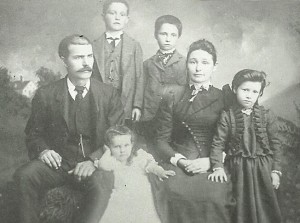 rarely depicted smiling in old paintings or why people didn’t start showing their pearly whites in the 1840s when exposure times for photos were under a minute. While these issues might have prevented some from smiling, the major reason for the serious looks was because most people thought smiling made them look ridiculous. Ultimately, the real reason folks didn’t smile was because they thought it made them look stupid. Many people don’t think they have a great smile. They think their smile makes them look goofy, and they didn’t want that to be how they were remembered. Mark Twain summed it up best when he said, “A photograph is a most important document, and there is nothing more damning to go down to posterity than a silly, foolish smile caught and fixed forever.”
rarely depicted smiling in old paintings or why people didn’t start showing their pearly whites in the 1840s when exposure times for photos were under a minute. While these issues might have prevented some from smiling, the major reason for the serious looks was because most people thought smiling made them look ridiculous. Ultimately, the real reason folks didn’t smile was because they thought it made them look stupid. Many people don’t think they have a great smile. They think their smile makes them look goofy, and they didn’t want that to be how they were remembered. Mark Twain summed it up best when he said, “A photograph is a most important document, and there is nothing more damning to go down to posterity than a silly, foolish smile caught and fixed forever.”
These days, that thought is ridiculous. People smiled and laughed in those days, so how could it make them look ridiculous? I find it funny that in different eras, different things are cool or not cool, or even ridiculous. It would seem that each generation has their own uniqueness, and often the prior generation things they are crazy…as do the future generations. According to Nicholas Jeeves, who wrote an extensive article on the topic, by the 17th century “it was a well-established fact that the only people who smiled broadly, in life and in art, were the poor, the lewd, the drunk, the innocent, and the entertainment.” These days, we smile in photos to 
 show happiness or warmth, but back then it was viewed as the equivalent of duckface…a look no self-respecting Victorian would want recorded. As photography advanced and became more common, folks didn’t have to choose a single expression to serve as their memorial for the ages, which opened them up to showing a range of expressions in photos. Still, we can only imagine what the people of the past would think of the hundreds of thousands of pics that are now taken every minute, complete with our foolish smirks, photobombs, and even goofy filtered selfies.
show happiness or warmth, but back then it was viewed as the equivalent of duckface…a look no self-respecting Victorian would want recorded. As photography advanced and became more common, folks didn’t have to choose a single expression to serve as their memorial for the ages, which opened them up to showing a range of expressions in photos. Still, we can only imagine what the people of the past would think of the hundreds of thousands of pics that are now taken every minute, complete with our foolish smirks, photobombs, and even goofy filtered selfies.

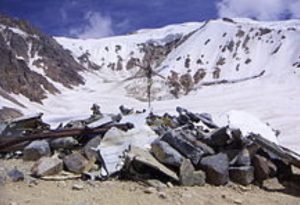 Years ago, I watched a movie about the survivors of a Uruguayan plane that crashed in the Andes Mountains. The crash and the survival amazed me, because against all odds, the 16 men who were rescued on December 22, 1972 had survived 72 days on a glacier at 11,710 feet in the bitter cold. The plane, a Fairchild FH-227D, was a chartered Uruguayan Air Force plane, designated as Flight 571, carrying 45 people. The flight carrying 19 members of a rugby team, family, supporters, and friends, took off from Montevideo, Uruguay on Friday, October 13, 1972, en route to Santiago, Chile. An error in the pilot’s calculations caused the plane to turn north too soon from the mountain pass it was going through, and put it on a collision course with the mountain peaks on either side of it. There were initially 28 people who survived the crash, but injuries, bitter cold, and an avalanche took the lives of all but the 16 who were rescued. The rescue might never have happened had not Nando Parrado and Roberto Canessa make the trek from the glacier known before the crash as the Valley of Tears, in the Cordillera.
Years ago, I watched a movie about the survivors of a Uruguayan plane that crashed in the Andes Mountains. The crash and the survival amazed me, because against all odds, the 16 men who were rescued on December 22, 1972 had survived 72 days on a glacier at 11,710 feet in the bitter cold. The plane, a Fairchild FH-227D, was a chartered Uruguayan Air Force plane, designated as Flight 571, carrying 45 people. The flight carrying 19 members of a rugby team, family, supporters, and friends, took off from Montevideo, Uruguay on Friday, October 13, 1972, en route to Santiago, Chile. An error in the pilot’s calculations caused the plane to turn north too soon from the mountain pass it was going through, and put it on a collision course with the mountain peaks on either side of it. There were initially 28 people who survived the crash, but injuries, bitter cold, and an avalanche took the lives of all but the 16 who were rescued. The rescue might never have happened had not Nando Parrado and Roberto Canessa make the trek from the glacier known before the crash as the Valley of Tears, in the Cordillera.
Recently I read another book on the flight, called Out Of The Silence: After The Crash by Eduardo Strauch, one of the survivors of the crash. The book was very good, and while it didn’t tell more than the movie had shown exactly, it put a very different perspective on the dire situation of the survivors, and the faith of the survivors and their loved ones, waiting at home for news. The book talked about the many premonitions, visions, and dreams that came out of the endless hours of waiting. It spoke of the several people who had a premonition before takeoff that the plane might crash. It spoke of the mother, who at the time of the crash had a vision of her son sitting in the plane seat covered in blood. She said that he looked like he was sleeping and she knew that he had died…she was right. It spoke of another mother who saw her son with just a bruise on his head, but very much alive. He was, and the bruise was where she saw it. And it spoke of the vivid dream Nando had, of the survivors being rescued by Christmas…which they were.
The book reminded me of times in my own life when I have experienced such “foretelling of things to come.” Because of my deep religious convictions I struggle with things like psychics and I don’t believe in séances or talking to the dead, but rather that God tells us of things to come, a truth which is found in His Word, the Bible. I recalled the time that I was at my mom and dad’s house, and Dad was at work. The phone rang, and I suddenly got an uncomfortable feeling that something had happened to my dad. I discounted it when the call on the phone that seemingly brought the feeling about, turned out to be something else. I went home, and when I got there, my mom called to tell me that a heavy steel beam had fallen on my dad’s foot, crushing his little toe, which is not protected by the steel toe on a boot. I have since marveled at the fact that I had that feeling at the precise time of the accident.
Mom also had such a “telling of things to come” after my Dad became ill in Canada, while they and my sister Cheryl were on vacation, driving on the north shore of Lake Superior. My sisters, Caryl, Alena, Allyn, and I had rushed to Canada to be with the them and hold vigil over our very ill dad. One night, Mom woke us all up saying that we needed to pack up, because we were going to be taking Dad home that day. At the time we thought that she was in a state of crazed delirium, due to the stress and seriousness of the situation. While listening to Nando’s announcement to his friends upon awaking from his dream on that mountain, saying that they would be home by Christmas, it occurred to me that while her timing was off, my mom was right in that Dad would leave that place and come back to his life here.
It is a very strange thing to know that God has spoken to you in such a way, and many people do not even believe that it happened, but too many of these incidences have taken place to discount them. There were 
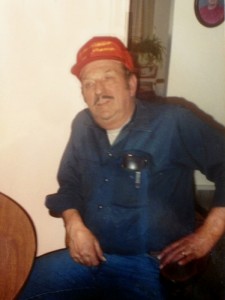 several people who worked in the World Trade Center on September 11, 2001, who were told by God not to go to work that day. Those who obeyed, were later shocked by what took place, and the part they might have played in those events. There was also a woman in the second tower, who when the announcement was made to return to their offices, was told by God to “get out of there and take as many people with her as she could.” She obeyed and saved a number of people who chose to listen to her warning that they must leave immediately. Whatever you choose to call these events, they are real, and while we never know at the moment they come, if we will look foolish for listening to them, or be exonerated when things play out exactly as we saw them…we find ourselves in the position of making a choice to listen or not to…come what may.
several people who worked in the World Trade Center on September 11, 2001, who were told by God not to go to work that day. Those who obeyed, were later shocked by what took place, and the part they might have played in those events. There was also a woman in the second tower, who when the announcement was made to return to their offices, was told by God to “get out of there and take as many people with her as she could.” She obeyed and saved a number of people who chose to listen to her warning that they must leave immediately. Whatever you choose to call these events, they are real, and while we never know at the moment they come, if we will look foolish for listening to them, or be exonerated when things play out exactly as we saw them…we find ourselves in the position of making a choice to listen or not to…come what may.
 These days, automation is commonplace. We have apps on our phones that can handle our payments at the register, and even let us skip the register and pay as we walk out the door. We have apps for home security, and even to turn things on and off from miles away. All that seems so normal to us these days, but imagine this kind of thing in 1956. I know that it sounds bizarre, but someone did think of a form of automation, even if it would seem primitive these days.
These days, automation is commonplace. We have apps on our phones that can handle our payments at the register, and even let us skip the register and pay as we walk out the door. We have apps for home security, and even to turn things on and off from miles away. All that seems so normal to us these days, but imagine this kind of thing in 1956. I know that it sounds bizarre, but someone did think of a form of automation, even if it would seem primitive these days.
On July 19, 1956, a model named Joan Lockwood selected items from a glass case at a completely automated section of a supermarket at the 30th Annual IGA Food Store Convention at the Waldorf-Astoria in New York. She put a large round “key” in a matching slot while she pressed buttons to make her selection. The items she selected were recorded on a tape inside the key. The machine tabulated the amount due on the purchases at the same time. It was just one of the systems that was proposed for supermarkets. The plan was to implement the system in the fall of 1956 in key  US cities. The three types of automation would be push-button selection in the store, checking of items on special cards at home or in the store, for electronic delivery by conveyor belt to the counter, and after-hours and Sunday automatic shopping of limited last minute supplies at coin machine units outside stores.
US cities. The three types of automation would be push-button selection in the store, checking of items on special cards at home or in the store, for electronic delivery by conveyor belt to the counter, and after-hours and Sunday automatic shopping of limited last minute supplies at coin machine units outside stores.
The shopping method that IGA Food Stores envisioned didn’t really seem plausible, and for an entire store, but then these days you can order online and pick up your order at Walmart, or have Target deliver it to you. I’m sure that wasn’t exactly what IGA had in mind with there system, and indeed it wasn’t what came of it at that time, but it did start the ball rolling for a type of shopping that we all take for granted these days…the vending machine. Of course, the vending machine can’t distribute everything, but it has gotten to the point of even being able to distribute foods that must be kept cold. It’s a very different type of vending machine than the old IGA machine, but it is most likely the brainchild of that old IGA system.
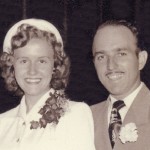
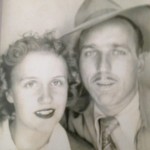 Thinking of my parents, Allen and Collene Spencer on their 66th wedding anniversary, the first thought that comes to mind is that it has been so very long since I’ve seen them. I wonder how the years could have gone by so fast. My dad has been in Heaven since 2007, and my mom since 2015. It seems like forever…probably because we have missed them every day since they have been gone. That’s how it goes with your parents, I think. While they are gone from this Earth, they are never gone from the hearts of the children who love them. They gave you life, nurtured you through your childhood years, and then let you spread you wings and fly free. They didn’t stifle your dreams, even if it meant that your were far away from them. That is the love of parents.
Thinking of my parents, Allen and Collene Spencer on their 66th wedding anniversary, the first thought that comes to mind is that it has been so very long since I’ve seen them. I wonder how the years could have gone by so fast. My dad has been in Heaven since 2007, and my mom since 2015. It seems like forever…probably because we have missed them every day since they have been gone. That’s how it goes with your parents, I think. While they are gone from this Earth, they are never gone from the hearts of the children who love them. They gave you life, nurtured you through your childhood years, and then let you spread you wings and fly free. They didn’t stifle your dreams, even if it meant that your were far away from them. That is the love of parents.
My own parents were all that and more for my four sisters and me. They were our rock, grounding us with their teachings and their faith in God. We always knew that no matter what happened or what mistakes we might make, they were there for us. They always had the answers we needed to resolve any situation. We would always view our lives as perfect. It didn’t matter what we might face later in their lives, or what they might need from us, we would always be there for them, just as they were for us. In fact, we never expected that they would need help from us. They seemed invincible. I suppose that is what made it so hard to face the day they went to Heaven. The knowledge that the world as we knew it would never be the same for us again, stunned us to our very core. It had not occurred to us that we would live on this Earth without parents, even if it should have. Still, once again, their teachings sustained us and, just as they knew we would, we were able to move forward in our lives. They had raised us to become independent women, after all. They knew that we would step up and become the new matriarchs of the family, bring the next generation forward to their own independence, so they could, in turn, raise their children to that level and so on. That was still part of the love of parents for their children.
Our parents showed us how to work at life. They knew that nothing in life is guaranteed, but with hard work, you can succeed in most areas of your life. Our parents showed us that being married isn’t always roses and 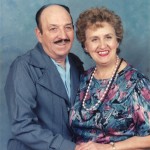
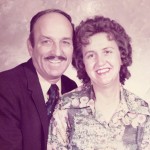 candy, but when you had a loving, solid marriage, it was always rewarding. Their years together, though cut short when Dad passed away in 2007, were filled with love and stability. The married years they spent on this Earth were 53 years, but while people are not married in Heaven, they will always love each other. Today would have been my parents 66th wedding anniversary. I know they are enjoying time together in Heaven, and it is a joyous day. Happy 66th anniversary in Heaven, Mom and Dad!! We love and miss you very much, and we will see you in the future.
candy, but when you had a loving, solid marriage, it was always rewarding. Their years together, though cut short when Dad passed away in 2007, were filled with love and stability. The married years they spent on this Earth were 53 years, but while people are not married in Heaven, they will always love each other. Today would have been my parents 66th wedding anniversary. I know they are enjoying time together in Heaven, and it is a joyous day. Happy 66th anniversary in Heaven, Mom and Dad!! We love and miss you very much, and we will see you in the future.

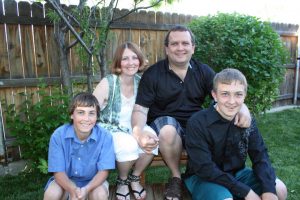 With each passing year, I find myself more and more impressed with how my daughter, Corrie Petersen and her husband, Kevin handle the changes of life as they come along. Corrie and Kevin have been married 26 years today, and they have seen many things in life change. Some changes were good, some were not, but all were handled together. We never know what problems life will throw our way, or what disappointments might come our way. The reality is that it isn’t really about what problems occur, but rather what you do with the aftermath that matters. No, their marriage hasn’t been fraught with problems, and in fact most of it was wonderful, but whenever something comes up, they handle it together.
With each passing year, I find myself more and more impressed with how my daughter, Corrie Petersen and her husband, Kevin handle the changes of life as they come along. Corrie and Kevin have been married 26 years today, and they have seen many things in life change. Some changes were good, some were not, but all were handled together. We never know what problems life will throw our way, or what disappointments might come our way. The reality is that it isn’t really about what problems occur, but rather what you do with the aftermath that matters. No, their marriage hasn’t been fraught with problems, and in fact most of it was wonderful, but whenever something comes up, they handle it together.
For Corrie, a disappointing job situation led her to consider making a big change that would require college in her 40’s, but Kevin has been really supportive and so, she is in nursing school, going for her degree. Kevin has Rheumatoid Arthritis and Fibromyalgia, that has caused him so much pain that he can’t work, but he has managed to hold down the home front while Corrie works and studies. He has been able to cook the meals for them, and since it’s just the two of them now, the house stays clean with little work. Kevin is Corrie’s biggest cheerleader, encouraging her and keeping her spirit up. It’s probably not what many would call conventional, but they have made it work. Once Corrie’s schooling is done, things will get even easier. Right now, holding down the home front means spending a lot of alone time with their Scottie dog, Dottie and their cat, Zoe.
The challenges the kids have handled have in no way kept them from the wonderful blessing they have been given. Their marriage has been blessed with two sons, a soon to be daughter-in-law, and a sweet little granddaughter. Life couldn’t possibly get better for them. They are enjoying every minute of being parents and grandparents. They have always loved kids, so this has been the next logical step for them. Life for 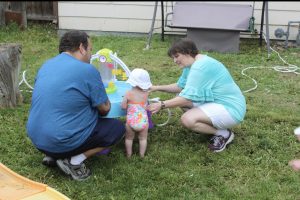
 Corrie and Kevin hasn’t always been perfect, but as a whole, it’s been pretty close to it. Today is their 26th anniversary. With each passing year, they become more and more lifetime members of the lifetime married club. It’s a great club to be members of, and I’m proud of them. These days lots of marriages don’t last, but theirs has endured. Happy 26th Anniversary Corrie and Kevin!! Have a great day!! We love you!!
Corrie and Kevin hasn’t always been perfect, but as a whole, it’s been pretty close to it. Today is their 26th anniversary. With each passing year, they become more and more lifetime members of the lifetime married club. It’s a great club to be members of, and I’m proud of them. These days lots of marriages don’t last, but theirs has endured. Happy 26th Anniversary Corrie and Kevin!! Have a great day!! We love you!!
 Many people have disappeared over the years…some were kidnapped and likely murdered, some were lost on a trip and no one knew where they ended up. Some even fell into a sinkhole or crevasse on a glacier, but while many of these were seen by someone one last time, none that I have ever heard of simply vanished into thin air in front of witnesses…at least not until I read about Orion Williamson.
Many people have disappeared over the years…some were kidnapped and likely murdered, some were lost on a trip and no one knew where they ended up. Some even fell into a sinkhole or crevasse on a glacier, but while many of these were seen by someone one last time, none that I have ever heard of simply vanished into thin air in front of witnesses…at least not until I read about Orion Williamson.
Orion Williamson was a farmer who lived with his wife and son in his farmhouse in Selma, Alabama in 1854. One sunny July afternoon, he was sitting on his front porch with his family. His neighbors, Armour Wren and his son, James were passing by. Orion stood up to move his grazing horses to the shade. He briefly stopped to pick up a small stick, which he absently swished back and forth as he walked in the ankle-deep grass. Orion waved to his neighbors, took one more step, and vanished into thin air. Had one witness seen this event, it could be easily disputed as a way to explain a man who had abandoned his family, but four witnesses…well, that was much harder to dispute.
Hardly able to believe their eyes, the Williamsons and the Wrens ran to the spot Orion disappeared in and searched for any sign of him. They found none. Most of the grass in the spot was gone too. There was no hole that he could have fallen into, no cliff he could have fallen down, and no burned area that might have suggested spontaneous combustion…just thin air, and missing grass. After hours of futile searching, Orion’s shocked family and neighbors went for help. A search party of three hundred men was formed, and they carefully and repeatedly combed every inch of the field. Later, bloodhounds joined the search. No sign of Orion materialized, even though the effort continued well into the night.
As news of the inexplicable vanishment spread, more volunteers and a team of geologists arrived. They dug up the field, looking for signs of instability. They reached solid rock a few feet below the surface. No holes, crevices, or cave-ins, nothing that could explain the event. Mrs Williamson and her son reported that they could hear Orion’s voice calling for help for weeks afterwards, ever growing fainter and fainter. Each time they would rush out onto the field, only to find nothing. Gradually, Orion’s voice faded into a mere whisper, then disappeared forever. It was almost as if he had moved into an alternate dimension, like a time warp or something. After massive searching turned up no signs of Williamson, the judge declared Orion dead. The following spring, it is said, a circle of dead grass appeared to mark the spot of the unlucky farmer’s disappearance.
The German scientist, Maximilian Hern, author of the book Disappearance and Theory Thereof, speculated that Orion walked into a spot of “universal ether,” because he believed these places lasted a few seconds and could completely destroy all matter within them. Still, that does not explain his family hearing his voice, assuming it was not imagined. Another scientist theorized a magnetic field had disintegrated Orion’s atomic structure and  sent him into another dimension. That might explain the alternate dimension theory, because I would never buy into the theory that “goblins did it,” since I don’t believe in goblins.
sent him into another dimension. That might explain the alternate dimension theory, because I would never buy into the theory that “goblins did it,” since I don’t believe in goblins.
Years later, a traveling salesman named McHatten rewrote the Williamson disappearance. In his version of the story, Orion’s name became David Lang, the place changed to Gallatin and the date was moved to 1880. Even though the Lang story was a fictional account, apart from the basic facts, Newspapers began to present it as truth in newspaper articles and books…by authors who didn’t do their homework anyway. Consequently, the fictional story is better known than the real vanishment behind it.
 Emma Gatewood was a survivor. When I read the first few lines about her, I thought her story was remarkable, but as I read the whole story, I realized just how remarkable she really was. Emma’s married life was pure torture, with the exception of her children, whom she dearly loved. Emma married her husband, Perry Clayton Gatewood, a 26 year old school teacher, turned farmer, when she was just 19 years old. He was a horrible man, who immediately put her to work building fences, burning tobacco beds, and mixing cement, in addition to her household chores. Three months after their wedding, he started to beat her, a practice he continued until, one day in 1939, he broke her teeth, cracked one of her ribs and bloodied her face. Women didn’t have as many options back then, so Emma was stuck. Because Emma threw a sack of flour at him, the police came and arrested her, not him, and put her in jail. The next day, when the mayor saw her battered face, he took her to his own home, where she remained under his protection until she got back on her feet.
Emma Gatewood was a survivor. When I read the first few lines about her, I thought her story was remarkable, but as I read the whole story, I realized just how remarkable she really was. Emma’s married life was pure torture, with the exception of her children, whom she dearly loved. Emma married her husband, Perry Clayton Gatewood, a 26 year old school teacher, turned farmer, when she was just 19 years old. He was a horrible man, who immediately put her to work building fences, burning tobacco beds, and mixing cement, in addition to her household chores. Three months after their wedding, he started to beat her, a practice he continued until, one day in 1939, he broke her teeth, cracked one of her ribs and bloodied her face. Women didn’t have as many options back then, so Emma was stuck. Because Emma threw a sack of flour at him, the police came and arrested her, not him, and put her in jail. The next day, when the mayor saw her battered face, he took her to his own home, where she remained under his protection until she got back on her feet.
Emma and Perry had 11 children, and unfortunately, the treatment of their mother was not hidden from them. Nevertheless, the story of Emma’s abuse at the hands of her husband went untold for more than a 50 years. In 2014, a newspaper reporter named Ben Montgomery, Emma’s great grand nephew, told her story in his book, “Grandma Gatewood’s Walk.” Emma Rowena (Caldwell) Gatewood passed away on June 04, 1973 in Gallipolis, Ohio, of an apparent heart attack, at the grand old age of 85, having accomplished much since her birth on  October 25, 1887, in Gallia County, Ohio. Her father, Hugh Caldwell, a farmer, had lost a leg after being wounded in the Civil War and in his depression, turned to a life of drinking and gambling. Her mother, Evelyn (Trowbridge) Caldwell, raised the couple’s 15 children, who slept four to a bed in the family’s log cabin.
October 25, 1887, in Gallia County, Ohio. Her father, Hugh Caldwell, a farmer, had lost a leg after being wounded in the Civil War and in his depression, turned to a life of drinking and gambling. Her mother, Evelyn (Trowbridge) Caldwell, raised the couple’s 15 children, who slept four to a bed in the family’s log cabin.
In an interview with her children, Montgomery, who worked for The Tampa Bay Times in Florida. In his research for the book, her surviving children spoke with him and entrusted him with her journals, letters, and scrapbooks. In that material he found stark references to what she had withheld from news interviewers: that her husband had nearly pummeled her to death several times. During one beating, she wrote, he broke a broom over her head. Her children told Montgomery that their father’s sexual hunger had been insatiable and that he forced himself on their mother several times a day. He made their lives a nightmare for years.
The woods became a place of solace and safety for Emma, who would often escape to them amid her husband’s rants. She came to view the wilderness as protective and restorative. In 1937 she left him and moved in with relatives in California. She was forced to leave behind two daughters, ages 9 and 11, who were still at home. Emma knew her husband would not beat the girls, and she could not afford to take them with her. She wrote to the girls to explain it to them, making sure not to leave a return address. In the letter, she wrote, “I have suffered enough at his hands to last me for the next hundred years.” Nevertheless, Emma couldn’t stand to be away from her girls any longer, so she returned after a few months. Her life became a prison after that. Her husband would not let her out of his sight. She later wrote that in 1938, he beat her “beyond recognition” 10 times. “For a lot of people the trail is a refuge,” Brian B. King, a publisher of guidebooks and maps for the Appalachian Trail Conservancy, said in a telephone interview. “But seldom is it a refuge for something as bad 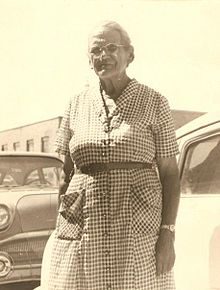 as that.” A short time later, her husband left for good, filed for divorce, which was granted in 1941, and he was out of her life.
as that.” A short time later, her husband left for good, filed for divorce, which was granted in 1941, and he was out of her life.
Emma’s hiking became a saving grace for her…she loved it. In 1949, she came across a National Geographic magazine article about the Appalachian Trail and became intrigued to learn in reading it that no woman had ever hiked it solo. In 1954, in her first attempt at hiking the Appalachian Trail, she started out in Maine, but broke her glasses, got lost, and was rescued by rangers, who told her to go home. Undaunted, she tried again in 1955, starting from Georgia this time. She was 67 years old, a mother of 11, a grandmother and even a great-grandmother when she became the first woman to hike the entire Appalachian Trail by herself in one season. She would go on to repeat the feat 2 more times. Soon everyone was calling her “America’s most celebrated pedestrian.” In 1959, Emma went on to conquer the 2,000 miles of the Oregon Trail, trekking alone from Independence, Missouri to Portland, Oregon.

 My nephew, Shannon Moore has had an interesting year. Shannon had been the special teams coach for Eastern Carolina University in Greenville, North Carolina, but at the end of last year, he accepted a position at the University Of Wyoming as their new assistant coach. He is also their tight ends coach and helps with special teams too. The really cool thing about that is that it puts them back in Wyoming, which is where my niece and his wife, Lindsay Moore was born and when her family all live. My sister and brother-in-law, and Lindsay’s parents, Allyn and Chris Hadlock have really missed being able to be closer to Lindsay and Shannon, especially since their daughter, Mackenzie was born on September 13, 2017. They are a close-knit family, and it was hard not being able to get to know Mackenzie better. Nevertheless, it was the best thing for Shannon and his little family at the time. Shannon’s coaching jobs have taken the family to several places, and each move was to a better position, so that was wonderful.
My nephew, Shannon Moore has had an interesting year. Shannon had been the special teams coach for Eastern Carolina University in Greenville, North Carolina, but at the end of last year, he accepted a position at the University Of Wyoming as their new assistant coach. He is also their tight ends coach and helps with special teams too. The really cool thing about that is that it puts them back in Wyoming, which is where my niece and his wife, Lindsay Moore was born and when her family all live. My sister and brother-in-law, and Lindsay’s parents, Allyn and Chris Hadlock have really missed being able to be closer to Lindsay and Shannon, especially since their daughter, Mackenzie was born on September 13, 2017. They are a close-knit family, and it was hard not being able to get to know Mackenzie better. Nevertheless, it was the best thing for Shannon and his little family at the time. Shannon’s coaching jobs have taken the family to several places, and each move was to a better position, so that was wonderful.
Since becoming “Daddy” to Mackenzie, Shannon is a new man. His daughter is the apple of his eye, and the fulfillment of his dreams!! They have such a wonderful bond. Mackenzie loves her daddy so much. Shannon is a great dad, so patient and loving! He loves to dote on her and play with her! He doesn’t care if she wants to play girly games, he is all in, and Mackenzie is her daddy’s littlest…in size only…cheerleader. She goes with her mommy to every game they can, and she knows to drill, “Put on your game face!!” Mackenzie is all about her daddy! She calls him and screams with delight when he answers. She waits for him to come home from work and when he comes in the door, she repeatedly screams, “Daddy!” Shannon is on cloud nine every time he hears his girl calling to him.
Lindsay and Shannon are very athletic, being back in Wyoming gives them the opportunity to do some hiking and exploring of the area. Of course, other than his family, football is Shannon’s passion, and he is always 
 ready for the next season to begin…whether its his team, or the pros, Shannon loves the game. In fact, had it not been for football, Lindsay and Shannon might not have met. It was at a Wyoming Cavalry indoor football game that they first laid eyes on each other, and the rest…as they say, is history. They were perfect for each other and everyone could see it…right from the start. Now, they have come full circle, landing back in Wyoming again…where it all started, and we are all very happy about that. Today is Shannon’s birthday, Happy birthday Shannon!! Have a great day!! We love you!!
ready for the next season to begin…whether its his team, or the pros, Shannon loves the game. In fact, had it not been for football, Lindsay and Shannon might not have met. It was at a Wyoming Cavalry indoor football game that they first laid eyes on each other, and the rest…as they say, is history. They were perfect for each other and everyone could see it…right from the start. Now, they have come full circle, landing back in Wyoming again…where it all started, and we are all very happy about that. Today is Shannon’s birthday, Happy birthday Shannon!! Have a great day!! We love you!!
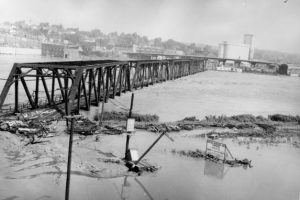 Rain…it waters the earth, and as we all know, without it, we could not survive. Nevertheless, as vital as water is to life on this planet, too much of it can be deadly. People can drink too much water, we can over-water our plants, and too much rain can bring flooding. Such was the case on July 13, 1951. Above-average rainfall began in June and continued through July 13th, dumping well over 25 inches on some areas in eastern Kansas. From July 9th to 13th, nearly 6 inches of rain fell. The Kansas, Neosho, and Verdigris rivers began taking on more water than their normal carrying capacity a couple of days into the storm, but as the rain persisted, flooding began all over the region.
Rain…it waters the earth, and as we all know, without it, we could not survive. Nevertheless, as vital as water is to life on this planet, too much of it can be deadly. People can drink too much water, we can over-water our plants, and too much rain can bring flooding. Such was the case on July 13, 1951. Above-average rainfall began in June and continued through July 13th, dumping well over 25 inches on some areas in eastern Kansas. From July 9th to 13th, nearly 6 inches of rain fell. The Kansas, Neosho, and Verdigris rivers began taking on more water than their normal carrying capacity a couple of days into the storm, but as the rain persisted, flooding began all over the region.
The major towns of Manhattan, Topeka and Lawrence took the biggest hit. As is  the case in any area where absorption is hampered by cement and asphalt, the rain could not soak in, and the ground was are already saturated anyway. The rain had nowhere to go, and the area was in trouble. Prior to the July 13 river crest, previous highs were dwarfed by four to nine feet. Two million acres of farmland were lost to the flood, which would trigger a crisis of its own, by a shortage of food. The flooding also caused fires and explosions in refinery oil tanks on the banks of the Kansas River. Passenger trains traveling through the area were stuck for nearly four days. In all, $760 million in damages were caused by the flood, and 500,000 people were left homeless, while 24 people died in the disaster. It was the greatest destruction from flooding in the Midwestern United States up to that time.
the case in any area where absorption is hampered by cement and asphalt, the rain could not soak in, and the ground was are already saturated anyway. The rain had nowhere to go, and the area was in trouble. Prior to the July 13 river crest, previous highs were dwarfed by four to nine feet. Two million acres of farmland were lost to the flood, which would trigger a crisis of its own, by a shortage of food. The flooding also caused fires and explosions in refinery oil tanks on the banks of the Kansas River. Passenger trains traveling through the area were stuck for nearly four days. In all, $760 million in damages were caused by the flood, and 500,000 people were left homeless, while 24 people died in the disaster. It was the greatest destruction from flooding in the Midwestern United States up to that time.
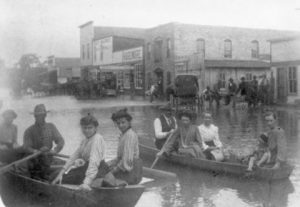
A often happen, tragedy brings change. Following the great 1951 flood, a series of reservoirs and levees were constructed all over the area. In 1993, these were credited with minimizing the damage from another record flood. Water is an element that is necessary for life, but lest we forget, water in an overabundance can kill and destroy. People need to pay attention to evacuation warnings, and get out of an area where a flood is eminent. You may lose some things, but if you leave the area, you will most likely to walk away unscathed, and as we know, things can be predicted, and those who head out of unsafe areas will most likely live to tell the tale.

 In a war, there are many heroes…some whose acts of courage and selflessness were so amazing that many felt they needed to receive a different medal…one that paid homage to the incredible things they did. Often these medals were even given posthumously because the brave act of the hero, cost the recipients their lives. Before 1861, no such medal existed. President Abraham Lincoln didn’t think that was right. There were many brave soldiers, and while not all brave acts would qualify for the medal of honor, the most self sacrificing of them would…the ones who set aside their own safety to protect the lives of others.
In a war, there are many heroes…some whose acts of courage and selflessness were so amazing that many felt they needed to receive a different medal…one that paid homage to the incredible things they did. Often these medals were even given posthumously because the brave act of the hero, cost the recipients their lives. Before 1861, no such medal existed. President Abraham Lincoln didn’t think that was right. There were many brave soldiers, and while not all brave acts would qualify for the medal of honor, the most self sacrificing of them would…the ones who set aside their own safety to protect the lives of others.
For that reason, President Abraham Lincoln signed into law a measure calling for the awarding of a US Army Medal of Honor, in the name of Congress, “to such noncommissioned officers and privates as shall most distinguish themselves by their gallantry in action, and other soldier-like qualities during the present insurrection.” The previous December, Lincoln had approved a provision creating a US Navy Medal of Valor, which was the basis of the Army Medal of Honor created by Congress on July 12, 1862. War puts men and women into situations whereby the only choices are kill or be killed. That can be a scary proposition. These soldiers do not do what they do in order to receive a medal. In fact, a medal rarely crosses their minds at all. The first US Army soldiers to receive what would become the nation’s highest military honor were six members of a Union raiding party who in 1862 penetrated deep into Confederate territory to destroy bridges and railroad tracks between Chattanooga, Tennessee, and Atlanta, Georgia.
In 1863, the Medal of Honor was made a permanent military decoration available to all members, including commissioned officers, of the US military. It is conferred upon those who have distinguished themselves in actual combat at risk of life beyond the call of duty. Since its creation, during the Civil War, more than 3,400 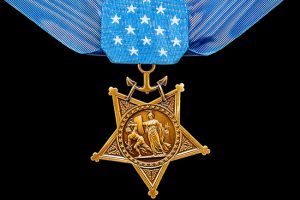
 men and one woman, Dr Mary Walker, have received the Medal of Honor for heroic actions in US military conflict. These people gave whatever it took to perform their duties. They were the best of the best, and the medal of honor was the best honor we could bestow on them. Of course, in Lincoln’s time, there was no air force, so that medal came later, as did the medals from the other branches of service, including the Coast Guard.
men and one woman, Dr Mary Walker, have received the Medal of Honor for heroic actions in US military conflict. These people gave whatever it took to perform their duties. They were the best of the best, and the medal of honor was the best honor we could bestow on them. Of course, in Lincoln’s time, there was no air force, so that medal came later, as did the medals from the other branches of service, including the Coast Guard.

